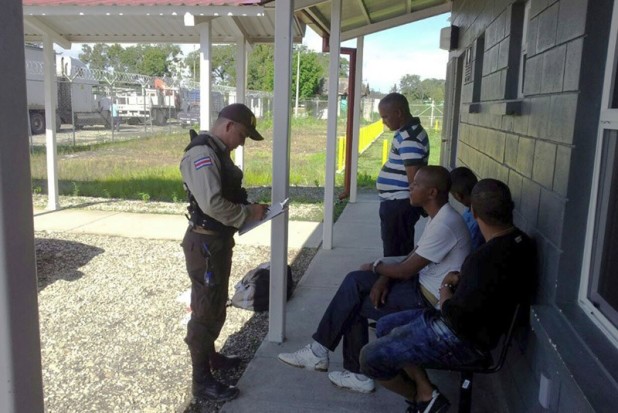The New Observer
January 27, 2016
More than 50,000 Cubans have been airlifted and bused into the US from all over Central America over the last few months, driven by an anticipation that Washington may soon halt the “wet foot, dry foot” migration policy.
Cubans detained in Costa Rica.
The “wet foot, dry foot” policy comes from the 1995 revision of the Cuban Adjustment Act of 1966, which said that anyone who fled Cuba and entered the United States would be granted permanent residence a year later.
In 1995, the US government agreed with Cuba that it would stop admitting people intercepted in US waters. Since then, a Cuban invader caught on the waters between the two nations (with “wet feet”) would summarily be sent home or to a third country.
However, an invader who makes it to shore (“dry feet”) gets a chance to remain in the United States, and later would qualify for expedited “legal permanent resident” status and eventually US citizenship.
It did not take long for the Cubans to realize that the legal loophole in this new rule was simply to enter the US via Mexico, and, having “dry feet,” they would be admitted to America.
As a result, more than 40,000 Cubans bought plane and boat tickets to Central American states, mostly landing in Ecuador, which offered visa-free entry for Cubans.
From there, they moved north via Nicaragua, but in mid-November, this route was blocked by the Nicaraguan government, which is an ally of Cuba. Thousands of Cuban invaders found themselves trapped in nations such as Costa Rica and Panama, with many thousands more on the way.
Then, the Central American Integration System (Sistema de la Integración Centroamericana, or SICA), which is the formal economic and political organization of Central American states, stepped in—and arranged flights for the invaders to El Salvador.
From there, they are bused up through Guatemala and Mexico to the US border, where all they have to do is present themselves, and then they immediately become parasites off the American taxpayer.
Costa Rica, for example, issued 8,000 temporary transit visas to Cuban invaders between November 14 and December 18 alone.
According to KRGV television in the Rio Grande Valley, Texas, there are still “thousands” of Cubans crossing the border every day in January 2016.
Reporting on January 26, 2016 from the Hidalgo International Bridge on the border, the KRGV report said that “at least 7,000 Cuban refugees are expected to come to the border in the next coming days.”
The KRGV report interviewed one of the “refugees,” identified as Giovanni Acosta, and asked him why he had made the journey.
He said, “In Cuba, there’s nothing. There’s no freedom. We came from Cuba because the pressure that we have there,” adding that he was waiting for his wife to come to the bridge so he can take her to Miami.
“She’s taking the same track as I once did. I did the same path, like all the Cubans did. I came from Ecuador. I walked for 27 days on the road,” he said.
The report added that Congressman Henry Cuellar’s office said Cuban invaders are “coming to Laredo’s Point of Entry every day and the numbers are increasing. They’re coming from Central America through Mexico to the border.”
It is not clear who is funding the flights and buses, as neither the US government or SICA were forthcoming on this point.
However, at least one US politician, Cuban-born Felix Roque, the current mayor of West New York, New Jersey, told the Tico Times in December 2015 that he had donated a six-figure sum to pay for the invaders’ travel costs.
Another article in the Tico Times from November revealed that the news of a rapprochement between the US and Cuba in December 2014 “set off a surge of emigration to the United States” on the overland route and in light of an attempt to eliminate the Cuban Adjustment Act completely.
Rep. Paul Gosar (R-Ariz.), for example, recently presented the “Ending Special National Origin-Based Immigration Programs for Cubans Act of 2015,” a bill that would revoke Cubans’ fast track to permanent residency, the Tico Times added.
In the meantime, the flood of Cubans seeking to leave their own self-created disaster zone continues to increase, and the American taxpayers—the majority of whom are whites—are once again called upon to subsidize the nonwhite invasion of their country.
 Daily Stormer The Most Censored Publication in History
Daily Stormer The Most Censored Publication in History



